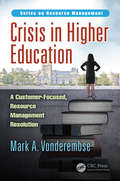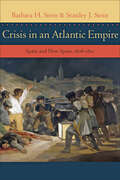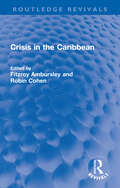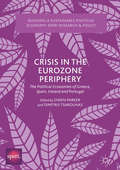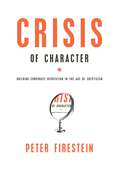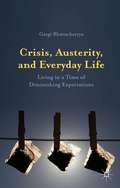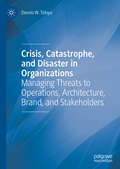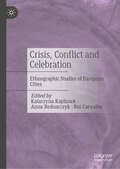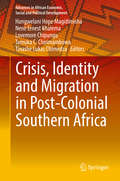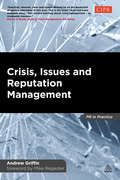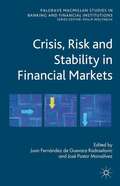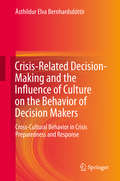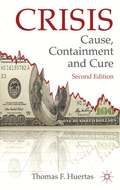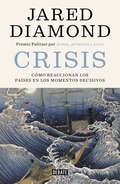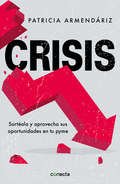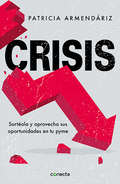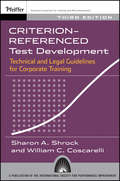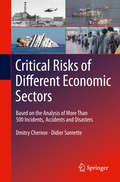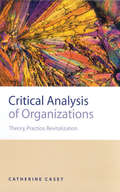- Table View
- List View
Crisis in Higher Education: A Customer-Focused, Resource Management Resolution (Resource Management)
by Mark A. VonderembseWhile many students, parents, educators, and organizations who hire their graduates hold US universities in high regard, the cost of higher education has risen much faster than the rate of inflation. High costs, in turn, have severely limited access to higher education for large portions of the US population or caused graduates and those who fall short of graduation to face substantial student loan debt. This book examines the root causes of these underlying problems and offers a comprehensive, easy-to-understand, high-impact solution. The book identifies actions that improve higher education outcomes including lower tuition costs, better access for student from low and middle income homes, faster throughput, fewer dropouts, and better job opportunities for graduates. It links a real and implementable solution to the underlying problems and their root causes. Upon finishing this book, readers should understand why the performance of higher education needs to improve and have solid ideas about how to fix it. The book focuses on public universities, but the ideas discussed are also applicable to private for-profit and not-for-profit universities. The writing style is simple and direct.
Crisis in an Atlantic Empire: Spain and New Spain, 1808-1810 (The Johns Hopkins University Studies in Historical and Political Science #131)
by Stanley J. Stein Barbara H. SteinThe capstone of a research endeavor begun by Barbara Stein and Stanley Stein nearly sixty years ago, this volume concludes their masterful tetralogy on Spanish economic and Atlantic history.With a compelling narrative that weaves together story and thesis and brings to life immense archival research and empirical data, Crisis in an Atlantic Empire is a finely grained historical tour of the period covering 1808 to 1810, which is often called "the age of revolutions."The study examines an accumulation of countervailing elements in a spasm of imperial crisis, as Spain and its major colony New Spain struggled to preserve traditional structures of exchange—Spain's transatlantic trade system—with Caribbean ports at Veracruz and Havana in wartime after 1804. Rooted in the struggle between businessmen seeking to expand their economic reach and the ruling class seeking to maintain its hegemonic control, the crisis sheds light on the contest between free trade and monopoly trade and the politics of preservation among an enduring and influential interest group: merchants.Reflecting the authors’ masterful use of archival sources and their magisterial knowledge of the era’s complex metropolitan and colonial institutions, this volume is the capstone of a research endeavor spanning nearly sixty years.
Crisis in the Caribbean (Routledge Revivals)
by Robin Cohen Fitzroy AmbursleyOriginally published in 1983, this anthology was the first to integrate the political experiences of the Central American mainland and the Caribbean archipelago and provides analyses of some of the most explosive events of the 1970s and 80s in this region, including the Jonestown massacre, the failures of the Burnham regime in Guyana, the tumultuous elections in Jamaica in 1980, the army officers’ coup d’état in Suriname, the revolutions in Grenada and Nicaragua and the revolutionary upheaval in El Salvador. It also shows how the regional crisis affected such prosperous countries as Trinidad and Tobago and such politically stable regimes in St. Vincent and the French colonies of Martinique and Guadelope. It also discusses the development of the first Socialist regime in the region, Cuba
Crisis in the European Monetary Union: A Core-Periphery Perspective (Routledge Studies in the European Economy)
by Giuseppe Celi Andrea Ginzburg Dario Guarascio Annamaria SimonazziAfter decades of economic integration and EU enlargement, the economic geography of Europe has shifted, with new peripheries emerging and the core showing signs of fragmentation. This book examines the paths of the core and peripheral countries, with a focus on their diverse productive capabilities and their interdependence. Crisis in the European Monetary Union: A Core-Periphery Perspective provides a new framework for analysing the economic crisis that has shaken the Eurozone countries. Its analysis goes beyond the short-term, to study the medium and long-term relations between ‘core’ countries (particularly Germany) and Southern European ‘peripheral’ countries. The authors argue that long-term sustainability means assigning the state a key role in guiding investment, which in turn implies industrial policies geared towards diversifying, innovating and strengthening the economic structures of peripheral countries to help them thrive. Offering a fresh angle on the European crisis, this volume will appeal to students, academics and policymakers interested in the past, present and future construction of Europe.
Crisis in the Eurozone
by Costas LapavitsasFirst, there was the credit crunch, and governments around the world stepped in to bail out the banks. The sequel to that debacle is the sovereign debt crisis, which has hit the eurozone hard. The hour has come to pay the piper, and ordinary citizens across Europe are growing to realize that socialism for the wealthy means punching a few new holes in their already-tightened belts.Building on his work as a leading member of the renowned Research on Money and Finance group, Costas Lapavitsas argues that European austerity is counterproductive. Cutbacks in public spending will mean a longer, deeper recession, worsen the burden of debt, further imperil banks, and may soon spell the end of monetary union itself.Crisis in the Eurozone charts a cautious path between political economy and radical economics to envisage a restructuring reliant on the forces of organized labour and civil society. The clear-headed rationalism at the heart of this book conveys a controversial message, unwelcome in many quarters but soon to be echoed across the continent: impoverished states have to quit the euro and cut their losses or worse hardship will ensue.
Crisis in the Eurozone Periphery
by Owen Parker Dimitris TsarouhasThis book investigates the causes and consequences of crisis in four countries of the Eurozone periphery – Greece, Spain, Portugal and Ireland. The contributions to this volume are provided from country-specific experts, and are organised into two themed subsections: the first analyses the economic dynamics at play in relation to each state, whilst the second considers their respective political situations. The work debates what made these states particularly susceptible to crisis, the response to the crisis and its resultant effects, as well as the manifestation of resistance to austerity. In doing so, Parker and Tsarouhas consider the implications of continued fragilities in the Eurozone both for these countries and for European integration more generally.
Crisis of Character: Building Corporate Reputation in the Age of Skepticism
by Peter FiresteinReputation matters—now more than ever. Public opinion in the wake of the financial meltdown has revealed the public’s abiding mistrust of corporations and the executives who run them. Scrutiny from the Internet and 24-hour cable TV offers companies no place to hide; so they must proactively seek the confidence of their shareholders and the public. In today’s economy, reputation is a prime factor in a corporation’s bottom line. Via its groundbreaking Seven Strategies of Reputation Leadership, Crisis of Character offers a fail-proof way for executives to immunize themselves and their companies against the breakdowns that can happen to even the most prominent organizations. Using real-life examples (from Merck and Citigroup to Hewlett-Packard and Coca-Cola), Crisis of Character presents concrete ways executives can shape the internal corporate culture to support their business interests. This book’s many stories vividly illustrate how corporate strategy must shift to deal effectively with globalization and the new environmental and human rights standards that come with it. Crisis of Character offers invaluable advice to anyone who operates in the public sphere—and who understands that reputation is the key to survival.
Crisis, Austerity, and Everyday Life: Living in a Time of Diminishing Expectations
by Gargi BhattacharyyaWill austerity never end? This timely and insightful book argues that austerity seeks to set the terms of political and economic life for the foreseeable future, extending techniques of exclusion to ever-greater sections of the population.
Crisis, Catastrophe, and Disaster in Organizations: Managing Threats to Operations, Architecture, Brand, and Stakeholders
by Dennis W. TafoyaThis book explores how and why an event is a precursor to the emergence of a crisis and how a given crisis affects an organization and its stakeholders. Using existing systems theory blended with innovative use of wave, epidemiological, immunological and psycho-social theories, the author discusses ways to understand the effects of different types of crises while showing how to document and/or quantitatively measure those effects. The book offers new models illustrating how events trigger crises and how they subsequently morph into catastrophes and disasters. Using theories and tools tested in organizational settings to identify contributors to a traumatic event, this book makes a valuable contribution to organizational and crisis management literature.
Crisis, Conflict and Celebration: Ethnographic Studies of European Cities
by Katarzyna Kajdanek Anna Bednarczyk Rui CarvalhoThis book illuminates how the profound challenges faced by contemporary societies over the past few decades, encompassing climate change and other environmental risks, global health threats, warfare, and mass migration, manifest themselves in European cities. The chapters bring cutting-edge ethnographic studies which address these complex issues through three key conceptual dimensions of urban life: crisis, conflict, and celebration. The concept of crisis is critically explored in its various economic, political and cultural dimensions affecting urban residents in multiple social and spatial aspects of their lives. Crises often lead to conflicts, dynamic processes that give rise to interest groups and complex social landscapes of resistance. By examining conflicts in urban contexts, the book uncovers the power dynamics and vulnerabilities emerging during turbulent times. Crises and conflicts also present opportunities for urban transformation and regeneration, bringing underlying beliefs and norms into question, paving the way for new social dynamics within urban environments. These conflictual spaces can therefore become arenas for celebration of urbanity, where communities express resilience, cultural identity, and collective solidarity. As well as providing new insights into the present and future of European cities and the pivotal role of urban areas as centers of social change, contestation, and community-building, the book provides an important methodological contribution through innovative qualitative research in a diverse range of European urban areas.
Crisis, Identity and Migration in Post-Colonial Southern Africa (Advances in African Economic, Social and Political Development)
by Nene Ernest Khalema Hangwelani Hope Magidimisha Lovemore Chipungu Tamuka C. Chirimambowa Tinashe Lukas ChimedzaThis book offers a socio-historical analysis of migration and the possibilities of regional integration in Southern Africa. It examines both the historical roots of and contemporary challenges regarding the social, economic, and geo-political causes of migration and its consequences (i. e. xenophobia) to illustrate how 'diaspora' migrations have shaped a sense of identity, citizenry, and belonging in the region. By discussing immigration policies and processes and highlighting how the struggle for belonging is mediated by new pressures concerning economic security, social inequality, and globalist challenges, the book develops policy responses to the challenge of social and economic exclusion, as well as xenophobic violence, in Southern Africa. This timely and highly informative book will appeal to all scholars, activists, and policy-makers looking to revisit migration policies and realign them with current globalization and regional integration trends.
Crisis, Issues and Reputation Management
by Andrew GriffinThe reputation of an organisation influences who we buy from, work for, supply to and invest in. In today's complex environment, organizations have to understand and respond rapidly to shifting public values, rising expectations, demands for public consultation and increasingly intrusive news media. This is particularly important when things go wrong. Crisis, Issues and Reputation Management outlines a comprehensive approach to managing situations that may turn into crises; handling crises once they occur; and features a wide range of case studies of brands who have had to respond to a variety of crises including Nestle, Unilever, General Electric, McDonald's, Coca-cola, Cadbury, Tesco, Pan Am, RBS and more. Crisis, Issues and Reputation Management defines reputation, explores how to value it and provides practical guidelines for effective reputation management, including advising companies on how to approach issues of Corporate Social Responsibility.
Crisis, Reform and the Way Forward in Greece: A Turbulent Decade (Europa Perspectives on the EU Single Market)
by Calliope SpanouThis volume discusses different aspects of Greece’s political economy during the past decade and reflects on the country’s path ahead, examining the major question: did this challenging period succeed in providing a window of opportunity for deeper institutional and societal change? The authors seek to contribute to the discussion of the dynamics of stability and change, of the nexus between external pressure and domestic agency. Greece offers a most interesting case study, as much in analytical as in empirical terms. Never before did a euro area member require three macroeconomic adjustment programmes under stringent policy conditionality and external supervision. This experience shattered past certainties and reshaped the political landscape. A decade later Greece was starting to recover and received international recognition for its reform efforts. However, the COVID-19 pandemic provided an external shock that risks derailing such achievements. The volume includes chapters by academics and researchers from different professional backgrounds: history, economics, public law, political science, public administration and political economy. Their diverse experience and viewpoints contribute to multidimensional analyses in subject areas such as Greece’s constitutional structure, public sector reforms, labour market developments, China’s expanding investment footprint and product market reforms.
Crisis, Resilience and Survival
by Holweg, Matthias and Oliver, Nick Matthias Holweg Nick OliverCrisis, Resilience and Survival charts the evolution of the global automotive industry, revealing the pressures and challenges facing firms in this huge but turbulent realm of business. Long-term overcapacity and swings of the economic cycle mean that many car companies are in financially perilous positions. Yet failures of auto companies are rare, and many have bounced back from the brink. Using the concept of the 'survival envelope', Holweg and Oliver argue that the ability to design, develop, manufacture and distribute vehicles competitively is not the only factor in ensuring success. Using detailed analyses of two failures (Rover and Saab) and two near-misses (Chrysler and Nissan) they explore how scale, market reach and supportive stakeholder relations can make the difference between success and failure in this global industry. This book will appeal to anyone working in, or studying the auto industry, as well as those interested in corporate success and failure.
Crisis, Risk and Stability in Financial Markets (Palgrave Macmillan Studies in Banking and Financial Institutions)
by Juan Fernández de Guevara Radoselovics José Manuel Pastor MonsálvezThis book presents an in-depth appreciation of key topics related to the behaviour of financial institutions in the crisis and stresses areas of major research interest. It covers a selection of papers specialising ranging from the analysis of bank and stock market performance in the crisis, to other areas such as microinsurance and social lending.
Crisis-Ready Teams: Data-Driven Lessons from Aviation, Nuclear Power, Emergency Medicine, and Mine Rescue (High Reliability and Crisis Management)
by Mary Waller Seth KaplanPrepare any team for peak performance when crisis comes. Crisis-Ready Teams explains how any team, and any team leader, in any industry or sector, can prepare in advance to manage crises that suddenly pull people together to address high-magnitude events that could seriously harm their organizations. The book is based on extensive, unprecedented research on crisis team dynamics, key success behaviors, and why some teams perform so much better than others. Leading scholars Mary J. Waller and Seth A. Kaplan recorded and statistically analyzed audio and video recordings of hundreds of hours of crisis simulations involving flight crews, nuclear power plant control rooms, mine rescues, emergency room doctors and nurses, etc. Based on this empirical research, and other academic literature on how teams perform in crises, the authors show how crisis teams and leaders can cement crucial behaviors through attention to team composition and communication, especially in the first few minutes of a crisis. The book provides a valuable framework and research data for scholars studying crises and teams in organizations. It is also appropriate for MBA or executive education instruction on crisis management and leadership.
Crisis-Related Decision-Making and the Influence of Culture on the Behavior of Decision Makers: Cross-Cultural Behavior in Crisis Preparedness and Response
by Ásthildur Elva BernhardsdóttirThis book provides an analysis on the impact of culture on crisis management, exploring how different cultural types are reflected in crisis-related decision making patterns. Providing an interdisciplinary and international perspective with a rich research and practical outlook, this work is an important contribution to the field of crisis management and decision making. Offering essential understanding to how countries, organizations, groups and individuals prepare for and respond to crises thus combining research across several disciplines, offering theoretical development, empirical testing and reporting on the testing of a large number of hypotheses across several frameworks. The novelty of this book lies in its presentation of the quantitative testing of the relationship between cultural theory and crisis management, drawing on data from cases that cross continents and crises types. The book also includes a review of cases from South Korea and suggests a number of ways in which practitioners at various levels of government can prepare their organizations to cope better with the introduction of cultural bias into the decision making process. Those with an interest in risk management, disaster management and crisis management will value this pioneering work as it reveals the influence of cultural bias in decision making processes. This work offers important insights for practice as well as for theory-building, scholars and practitioners of public administration, management, political, and international relations, organizational, social and cultural psychology, amongst others, will all gain from reading this work.
Crisis: Cause, Containment and Cure
by Thomas F. HuertasThe current crisis is emerging as the most severe downturn since the Great Depression. This book examines its cause, the efforts to contain the crisis and proposes a cure that will limit the risk that such crises could recur in the future.
Crisis: Cómo reaccionan los países en los momentos decisivos
by Jared DiamondJared Diamond culmina su trilogía con un sobrecogedor estudio de cómo las naciones más poderosas afrontan sus horas más oscuras. En Armas, gérmenes y acero y en Colapso, Jared Diamond ya revolucionó nuestra visión del auge y la caída de las civilizaciones. Ahora, el autor concluye su sensacional trilogía adentrándose en una dimensión psicológica que complementa el impresionante universo histórico, geográfico y económico recogido en su obra. El resultado es este revelador estudio comparativo de cómo seis países han sobrevivido en su historia reciente a crisis decisivas mediante un duro proceso de autoevaluación y transformación. Diamond identifica patrones en la superación de la adversidad y, dirigiendo su mirada hacia el futuro, plantea que quizás el mundo esté desperdiciando sus recursos y embarcándose en un viaje de conflicto político y declive. Una narración tan épica como irresistible. Reseñas:«Un recorrido fascinante y revelador por el modo en que las naciones afrontan sus peores crisis.»Yuval Noah Harari «Me entusiasma todo lo que escribe Jared Diamond, y este libro no es una excepción.»Bill Gates «Ningún científico ha ganado jamás un Nobel de Literatura. Jared Diamond debería ser el primero.»Michael Shermer «Jared Diamond ha vuelto a conseguirlo:otra narración sólida, original y fascinante sobre la historia de la humanidad. Esta vez, el autor nos revela cómo algunas sociedadeshan superado durísimas crisis, de las que podemos sacar lecciones vitales en estos tiempos tan difíciles.»Steven Pinker
Crisis: Sortéala y aprovecha sus oportunidades en tu pyme
by Patricia ArmendárizConoce el impacto y duración de la crisis en cada sector de la economía y aplica una sólida estrategia para sobrevivir y crecer. Patricia Armendáriz vierte toda su experiencia a lo largo de varias décadas en el sector financiero, como economista, empresaria social,inversionista de capital y juez de Shark Tank México para arrojar luz a la incertidumbre económica que presenta el 2020 para las pymes mexicanas. Tras un atinado análisis de la situación actual de la pandemia y su proyección en los próximos meses, Patricia responde las preguntas que tanta ansiedad nos causan: cuánto va a durar, cómo impactará la crisis en cada sector, cuáles serán los retos del nuevo mundo poscoronavirus y qué debemos hacer para sobrevivir tanto la caída como la salida del túnel. Siguiendo sus estrategias y consejos, podrás blindar tu pyme de los golpes a tu sector, enfrentarlos con resiliencia y, sobre todo, aprovechar las oportunidades que se presenten para crecer tus ingresos al porcentaje que tú decidas. Sí, leíste bien, crecer es una posibilidad y casi una necesidad; está en tus manos hacerla realidad. Un libro inmediato que busca no solo tu beneficio particular y el de tus empleados, sino, mediante la suma de todos los esfuerzos, sostener la economía mexicana a través del pilar más importante del empleo en México: las pymes.
Crisis: Sortéala y aprovecha sus oportunidades en tu pyme
by Patricia ArmendárizConoce el impacto y duración de la crisis en cada sector de la economía y aplica una sólida estrategia para sobrevivir y crecer. Patricia Armendáriz vierte toda su experiencia a lo largo de varias décadas en el sector financiero, como economista, empresaria social,inversionista de capital y juez de Shark Tank México para arrojar luz a la incertidumbre económica que presenta el 2020 para las pymes mexicanas. Tras un atinado análisis de la situación actual de la pandemia y su proyección en los próximos meses, Patricia responde las preguntas que tanta ansiedad nos causan: cuánto va a durar, cómo impactará la crisis en cada sector, cuáles serán los retos del nuevo mundo poscoronavirus y qué debemos hacer para sobrevivir tanto la caída como la salida del túnel. Siguiendo sus estrategias y consejos, podrás blindar tu pyme de los golpes a tu sector, enfrentarlos con resiliencia y, sobre todo, aprovechar las oportunidades que se presenten para crecer tus ingresos al porcentaje que tú decidas. Sí, leíste bien, crecer es una posibilidad y casi una necesidad; está en tus manos hacerla realidad. Un libro inmediato que busca no solo tu beneficio particular y el de tus empleados, sino, mediante la suma de todos los esfuerzos, sostener la economía mexicana a través del pilar más importante del empleo en México: las pymes.
Crisis: When Disaster Strikes IT
by Robert D. Austin Richard L. Nolan Shannon O'Donnell"The Adventures of an IT Leader" invites readers to "walk in the shoes" of Jim Barton, the new CIO of the fictional IVK Corporation, as he spends a difficult year learning effective information technology leadership, sidestepping the pitfalls that make the CIO job the most volatile, high-turnover job in the business. After three months of steady improvements in IT and the company at large, disaster strikes. This chapter joins Barton as he and his team troubleshoot a systems security breach. This chapter is excerpted from "The Adventures of an IT Leader."
Criterion-referenced Test Development
by Sharon A. Shrock William C. CoscarelliCriterion-Referenced Test Development is designed specifically for training professionals who need to better understand how to develop criterion-referenced tests (CRTs). This important resource offers step-by-step guidance for how to make and defend Level 2 testing decisions, how to write test questions and performance scales that match jobs, and how to show that those certified as ?masters? are truly masters. A comprehensive guide to the development and use of CRTs, the book provides information about a variety of topics, including different methods of test interpretations, test construction, item formats, test scoring, reliability and validation methods, test administration, a score reporting, as well as the legal and liability issues surrounding testing. New revisions include: Illustrative real-world examples. Issues of test security. Advice on the use of test creation software. Expanded sections on performance testing. Single administration techniques for calculating reliability. Updated legal and compliance guidelines.Order the third edition of this classic and comprehensive reference guide to the theory and practice of organizational tests today.
Critical Risks of Different Economic Sectors: Based on the Analysis of More Than 500 Incidents, Accidents and Disasters
by Didier Sornette Dmitry ChernovThis book explores the major differences between the kinds of risk encountered in different sectors of industry - production (including agriculture) and services - and identifies the main features of accidents within different industries. Because of these differences, unique risk-mitigation measures will need to be implemented in one industry that cannot be implemented in another, leading to large managerial differences between these broad economic sectors. Based on the analysis of more than 500 disasters, accidents and incidents - around 230 cases from the production sector and around 280 cases from the service sector - the authors compare the risk response actions appropriate within different sectors, and establish when and how it is possible to generalize the experience of dealing with risks in any given industry to a wider field of economic activity. This book is mainly intended for executives, strategists, senior risk managers of enterprise-wide organizations and risk management experts engaged in academic or consulting work. By setting out clearly the sector differences in risk management, the authors aim to improve the practice of general risk assessment with regard to identifying and prioritizing risks, and of risk control with regard to planning appropriate mitigation measures.
Critical Analysis of Organizations: Theory, Practice, Revitalization
by Catherine Joan Casey`Catherine Casey has written an excellent book that provides a lucid and comprehensive critical analysis of organizations....[It] extends in reach and relevance beyond the specific field of organization studies and the sociology of organizations to encompass broader intellectual developments that have had a significant impact on contemporary sociology and cultural studies' - Barry Smart, Professor of Sociology, University of Portsmouth `I anticipate that it will prove to be an attractive book in organization studies, industrial sociology and general sociology. I am sure that this will be a book that will make a major impact' - Mike Reed, Professor of Organization Theory, Lancaster University In this comprehensive and scholarly book, the essential critical strands in organizational analysis are explained. It examines how central traditions have realigned in relation to the challenge of postmodernism and the new reflexive turn in organizational studies. Judicious, innovative and written with the needs of students in mind, this book offers a renewed and revitalized critical accent in organization studies - one that focuses on existing and emerging social tendencies, contestations and struggles. It will be essential reading for senior students of organization studies and sociology.
